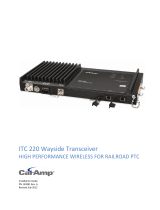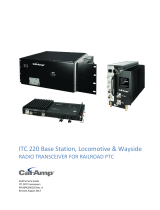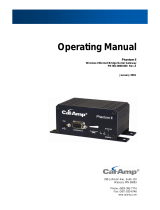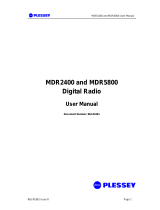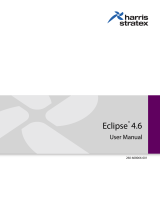Page is loading ...

IMPORTANT
BEFORE INSTALLING, MAINTAINING, OR USING YOUR RADIO TRANSCEIVER, READ THIS GUIDE
WHICH CONTAINS IMPORTANT RF ENERGY AWARENESS AND CONTROL INFORMATION AND
OPERATIONAL INSTRUCTIONS TO ENSURE COMPLIANCE WITH FCC OR INDUSTRY CANADA RF
EXPOSURE GUIDELINES.
IMPORTANT
RETAIN THIS GUIDE AT THE LOCATION OF THE RADIO TRANSCEIVER INSTALLATION.
RF Energy Exposure Guide for
ITC 220 Base Station, Locomotive, and Wayside Transceivers
Installed in Vehicles or at Fixed Sites
Radio Frequency Energy Exposure Guide
ITC 220 Base Station, Locomotive & Wayside Transceivers
PN 134069 Rev. A
Revised July 2012

REVISION HISTORY
REV
DATE
REVISION DETAILS
A
July 2012
Initial release. Part number 134069.

RF Energy Exposure Guide for ITC 220 Base Station, Locomotive, and Wayside Transceivers Installed in Vehicles or at Fixed Sites 134069 Rev A | Page i
Important Notice
Because of the nature of wireless communication, transmission and reception of data can never be
guaranteed. Data may be delayed, corrupted (i.e. have errors), or be totally lost. Significant delays or losses
of data are rare when wireless devices such as CalAmp provides are used in a normal manner with a well-
constructed network. These products should not be used in situations where failure to transmit or receive
data could result in damage of any kind to the user or any other party, including but not limited to personal
injury or death, or loss of property. CalAmp accepts no responsibility for damages of any kind resulting from
delays or errors in data transmitted or received using the ITC 220 Base Station, Locomotive, or Wayside
Transceiver, or for failure to transmit or receive such data.
Copyright Notice
© Copyright 2012 CalAmp. All rights reserved.
Products offered may contain software proprietary to CalAmp or other parties. The offer of supply of these
products and services does not include or infer any transfer of ownership. No part of the documentation or
information supplied may be divulged to any third party without the express written consent of CalAmp.
CalAmp reserves the right to update its products, software, or documentation without obligation to notify
any individual or entity. Product updates may result in differences between the information provided in this
manual and the product shipped. For access to the most current product documentation and application
notes, visit www.calamp.com.
RF Exposure Compliance Requirements
The ITC 220 Base Station, Locomotive, and Wayside Transceivers are intended for use in
the railroad industry as Interoperable Train Control (ITC) Radio (ITCR), which is an
important component of Positive Train Control (PTC). The ITC 220 Base station,
Locomotive, and Wayside Transceiver units must be professionally installed and must
ensure a minimum separation distance between the antenna or radiating structure and
any person. Refer to Table 1 and 2 on pages 3 and 4 of this RF Energy Exposure Guide for
recommended minimum lateral distance, as applicable for the antenna type and
application and transmitting power.
Radio Transceiver Model
Antenna application
Section and applicable table
ITC 220 Base Station Transceiver
Fixed installation
Section 6 Fixed Installations; Table 2 on Page 5
ITC 220 Locomotive Transceiver
Mobile installation
Section 4 Mobile Installations; Table 1 on Page 3
ITC 220 Wayside Transceiver
Fixed installation
Section 6 Fixed Installations; Table 2 on Page 5
ITC 220 Wayside Transceiver
Mobile installation
Section 4 Mobile Installations; Table 1 on Page 3
It is the responsibility of the user to guarantee compliance with the FCC MPE regulations when operating this
device in a way other than described above. The installer of this equipment must ensure the antenna is
located or pointed such that it does not emit an RF field in excess of Health Canada limits for the general
population.
ITC 220 Base Station, Locomotive, and Wayside Transceivers use a low power radio frequency transmitter.
The concentrated energy from an antenna may pose a health hazard. People should not be in front of the
antenna when the transmitter is operating.
Recommended safety guidelines for the human exposure to radio frequency electromagnetic energy are
contained in the Canadian Safety Code 6 (available from Health Canada), the Federal Communications
Commission (FCC) Bulletin 65 and the Council of the European Union’s Recommendation of 12 July 1999 on
the limitation of exposure of the general public to electromagnetic fields (0 Hz to 300 GHz) (1999/519/EC).
Any changes or modifications not expressly approved by the party responsible for compliance (in the
country where used) could void the user’s authority to operate the equipment.

RF Energy Exposure Guide for ITC 220 Base Station, Locomotive, and Wayside Transceivers Installed in Vehicles or at Fixed Sites 134069 Rev A | Page ii
TABLE OF CONTENTS
1 RF Energy Exposure Awareness and Control Information and Operational Instructions for FCC/IC
Occupational Use Requirements .................................................................................................... 1
2 FCC / Industry Canada Regulations ................................................................................................. 1
3 Compliance with RF Exposure Standard ......................................................................................... 1
3.1 Your CalAmp radio transceiver complies with the following RF energy exposure standards and guidelines as of
the date of manufacture: ....................................................................................................................................... 2
4 Mobile Installations: RF Exposure Compliance, Control Guidelines, and Operating Instructions . 3
4.1 Guidelines .............................................................................................................................................................. 3
4.2 Operator Instructions ............................................................................................................................................. 3
5 Mobile Antenna Installation Guidelines ......................................................................................... 4
6 Fixed Installations: RF Exposure Compliance Control Guidelines and Operating Instructions ...... 5
7 Approved Accessories ..................................................................................................................... 6
8 CalAmp Contact Information .......................................................................................................... 6
8.1 Factory and Technical Support ............................................................................................................................... 6
8.2 Customer Service ................................................................................................................................................... 6
9 Documentation and Downloads ..................................................................................................... 6
APPENDIX A: Abbreviations and Definitions ......................................................................................... 7

RF Energy Exposure Guide for ITC 220 Base Station, Locomotive, and Wayside Transceivers Installed in Vehicles or at Fixed Sites 134069 Rev A | Page 1
1 RF ENERGY EXPOSURE AWARENESS AND CONTROL INFORMATION AND OPERATIONAL
INSTRUCTIONS FOR FCC/IC OCCUPATIONAL USE REQUIREMENTS
NOTICE: This radio transceiver is intended for use in occupational/controlled conditions, where users have full
knowledge of their exposure and can exercise control over their exposure to meet FCC/IC limits. This radio
device is NOT authorized for general population, consumer, or any other use.
This radio transceiver uses electromagnetic energy in the radio frequency (RF) spectrum to provide
communications between two or more users over a distance. It uses RF energy or radio waves to send and receive
messages. RF energy is one form of electromagnetic energy. Other forms include, but are not limited to, sunlight
and x-rays. RF energy, however, should not be confused with these other forms of electromagnetic energy, which
when used improperly, can cause biological damage. Very high levels of x-rays, for example, can damage tissues
and genetic material.
Experts in science, engineering, medicine, health, and industry work with organizations to develop standards for
safe exposure to RF energy. These standards provide recommended levels of RF exposure for both workers and the
general public. These recommended RF exposure levels include substantial margins of protection.
All radio transceivers marketed in North America are designed, manufactured, and tested to ensure they meet
government-established RF exposure levels. In addition, manufacturers also recommend specific operating
instructions to users of radio transceivers. These instructions are important because they inform users about RF
energy exposure and provide simple procedures on how to control it. Please refer to the following Web sites for
more information about what RF energy exposure is and how to control your exposure to assure compliance with
established RF exposure limits.
http://www.fcc.gov/oet/rfsafety/rf-faqs.html
http://www.osha.gov/SLTC/radiofrequencyradiation/index.html
2 FCC / INDUSTRY CANADA REGULATIONS
The FCC/IC rules require manufacturers to comply with the FCC/IC RF energy exposure limits for mobile radio
transceivers before they can be marketed in the U.S. or Canada as applicable. When radio transceivers are used as
a consequence of employment, the FCC/IC requires users to be fully aware of and able to control their exposure to
meet occupational requirements. Your CalAmp user manuals and this RF Energy Exposure Guide include
information and operating instructions required to control your RF exposure and to satisfy compliance
requirements.
3 COMPLIANCE WITH RF EXPOSURE STANDARD
Your CalAmp radio transceiver is designed and tested to comply with a number of national and international
standards and guidelines (listed below) regarding human exposure to radio frequency electromagnetic energy. This
radio complies with IEEE and ICNIRP exposure limits for occupational/controlled RF exposure environment at duty
factors as shown in Table 1 and Table 2 and is authorized by the FCC/IC for occupational use. In terms of measuring
RF energy for compliance with the FCC/IC exposure guidelines, your radio antenna radiates measurable RF energy
only while it is transmitting, not when it is receiving or in standby mode.

RF Energy Exposure Guide for ITC 220 Base Station, Locomotive, and Wayside Transceivers Installed in Vehicles or at Fixed Sites 134069 Rev A | Page 2
3.1 YOUR CALAMP RADIO TRANSCEIVER COMPLIES WITH THE FOLLOWING RF ENERGY
EXPOSURE STANDARDS AND GUIDELINES AS OF THE DATE OF MANUFACTURE:
U.S. Federal Communications Commission, Code of Federal Regulations; 47CFR Part 2 Subpart J
Industry Canada RSS-102 Issue 4
American National Standards Institute (ANSI) / Institute of Electrical and Electronic Engineers (IEEE) C95.1-
1992
Institute of Electrical and Electronic Engineers (IEEE) C95.1-1999 Edition

RF Energy Exposure Guide for ITC 220 Base Station, Locomotive, and Wayside Transceivers Installed in Vehicles or at Fixed Sites 134069 Rev A | Page 3
4 MOBILE INSTALLATIONS: RF EXPOSURE COMPLIANCE, CONTROL GUIDELINES, AND
OPERATING INSTRUCTIONS
To control exposure to yourself and others and to ensure compliance with occupational/controlled environment
limits, always adhere to the following procedures.
4.1 GUIDELINES
These user awareness instructions should accompany the device or vehicle that it is installed when
transferred to other users.
Do not use this device if the operational requirements described herein are not met.
4.2 OPERATOR INSTRUCTIONS
Be aware that a transmitter may operate automatically at any time when functioning as a data radio
transceiver. People outside of the vehicle must maintain recommended minimum lateral distance from the
antennas at all times. It is the responsibility of the vehicle’s operator to keep bystanders beyond the
minimum lateral distance from the antennas in order to comply with the FCC RF exposure limits for an
uncontrolled/general population environment.
Verify that people outside the vehicle are at least the recommended minimum lateral distance away, as
shown in Table 1, from a properly installed externally-mounted antenna.
The transmitter power is adjustable to accommodate the various installations of this product. Once the
authorized ERP, antenna gain and the losses from the feed line, connectors and any inline RF filters are
known, the transmitter power must be evaluated and if necessary, set to a value that will ensure that the
authorized ERP and RF exposure requirements are met. Refer to the user manual for the particular radio
model for additional information regarding power adjustment.
Table 1 below lists the recommended lateral distances to be maintained between bystanders and approved,
properly installed mobile transmitting antennas in an uncontrolled environment.
Table 1 — Rated Power and Recommended Lateral Distance from Transmitting Antennas in Mobile Applications
Radio Type
Antenna Type
Antenna
gain
(dbi)
Nominal
PEP
(watts)
Maximum
Duty Cycle
Recommended minimum lateral
distance from transmitting
antenna
cm
in.
Wayside*
¼-wave dipole mounted to
roof or trunk of vehicle
2.15
30
10%
31.6
12.4
Wayside*
½-wave dipole mounted to
roof or trunk of vehicle
4.55
28.77
10%
40.4
15.9
Locomotive
Locomotive antenna 0 dBd
mounted to roof of
locomotive
2.15
50
30%
70
27.6
*When Wayside Transceiver is used in a mobile application.

RF Energy Exposure Guide for ITC 220 Base Station, Locomotive, and Wayside Transceivers Installed in Vehicles or at Fixed Sites 134069 Rev A | Page 4
IMPORTANT
The licensee is required to comply with limits on frequency use, antenna location, power and
effective antenna height per 47CFR Subpart T §90.701 et. seq., or Industry Canada SRSP-512
§6.3 as applicable.
Note: You, as the vehicle operator, should be knowledgeable of the location of each of the
antennas on the vehicle and of the minimum lateral distances applicable to each. If this
information is not available to you, contact your installer to obtain this information. Until this
information is available to you, keep bystanders at a distance beyond the largest lateral
distance specified in Table 1 from every radio transceiver antenna on the vehicle.
5 MOBILE ANTENNA INSTALLATION GUIDELINES
The following instructions apply only to vehicles with metal bodies or suitable ground plane:
Mount each antenna connected to a transmitter in the center of the roof or trunk lid of the vehicle. When
mounting an antenna to a trunk lid, be sure the minimum lateral separation distances (Table 1) are maintained
with respect to back seat passengers and people that might be standing next to a stationary vehicle.
Install all antennas in accordance with manufacturer’s instructions.
Always disable the transmitter when installing or servicing the antenna or transmission line or when working
near an installed antenna.
Use only CalAmp-supplied or CalAmp-approved antennas. Unauthorized antennas, modifications, or
attachments could damage the radio and their use may violate FCC or IC regulations.

RF Energy Exposure Guide for ITC 220 Base Station, Locomotive, and Wayside Transceivers Installed in Vehicles or at Fixed Sites 134069 Rev A | Page 5
6 FIXED INSTALLATIONS: RF EXPOSURE COMPLIANCE CONTROL GUIDELINES AND
OPERATING INSTRUCTIONS
To control exposure to yourself and others and to ensure compliance with RF exposure limits, always adhere to the
following procedures:
Base station or fixed antennas should be installed on permanent outdoor structures, such as the roof of a
building or antenna tower.
Install all antennas in accordance with the manufacturer’s instructions.
Always disable the transmitter when installing or servicing an antenna or transmission line or when working
near an installed antenna.
Use only CalAmp-supplied or CalAmp-approved antennas. Unauthorized antennas, modifications, or
attachments could damage the radio and their use may violate FCC or IC regulations.
RF Exposure compliance at such sites must be addressed on a site-by-site basis. It is the responsibility of the
licensee to ensure compliance is met.
The transmitter power is adjustable to accommodate the various installations of this product. Once the
authorized ERP, antenna gain, and the losses from feed line, connectors, and any inline RF filters are known,
the transmitter power must be evaluated and if necessary, set to a value that will ensure that the authorized
ERP and RF exposure requirements are met. Refer to the user manual for the particular radio manual for
additional information regarding power adjustment.
Table 2 below lists the recommended lateral distances to be maintained between bystanders and approved,
properly installed fixed transmitting antennas in an uncontrolled environment.
Table 2 — Rated Power and Recommended Lateral Distance from Transmitting Antennas in Fixed Applications
Radio
Type
Antenna Type
Antenna
gain
(dbi)
Nominal
PEP
(watts)
Maximum
Duty Cycle
Recommended minimum lateral
distance from transmitting antenna
cm
in.
Wayside
2.0 dBd exposed dipole
tower leg-mounted fixed
antenna
4.1
30
10%
39.6
15.6
Wayside
5.5 dBd exposed dipole
tower leg-mounted fixed
antenna
7.6
14.26
10%
40.4
15.9
Base
2.0 dBd exposed dipole
tower leg-mounted fixed
antenna
4.1
75
50%
140
55.0
Base
5.5 dBd exposed dipole
tower leg-mounted fixed
antenna
7.6
75
50%
209
82.3
IMPORTANT
The licensee is required to comply with limits on frequency use, antenna location, power and
effective antenna height per 47CFR Subpart T §90.701 et. seq., or Industry Canada SRSP-512
§6.3 as applicable.

RF Energy Exposure Guide for ITC 220 Base Station, Locomotive, and Wayside Transceivers Installed in Vehicles or at Fixed Sites 134069 Rev A | Page 6
7 APPROVED ACCESSORIES
For a list of CalAmp approved accessories, refer to the user manual or contact CalAmp.
8 CALAMP CONTACT INFORMATION
For additional information about exposure requirements or other information, please visit the CalAmp Web site
online at www.calamp.com.
8.1 FACTORY AND TECHNICAL SUPPORT
M-F 7:30-4:30 CST
CalAmp
1401 North Rice Avenue, Oxnard, CA 93030
Tel 805.987.9000; Fax 805.987.8359
Email wngsupport@calamp.com
8.2 CUSTOMER SERVICE
CalAmp
1401 North Rice Avenue
Oxnard, CA 93030
Tel 1.805.987.9000
BE SURE TO HAVE THE EQUIPMENT MODEL AND SERIAL NUMBER, AND BILLING AND SHIPPING ADDRESSES ON
HAND WHEN CALLING.
For units in warranty, customers are responsible for shipping charges to CalAmp. For units returned out of
warranty, customers are responsible for all shipping charges. Return shipping instructions are the responsibility of
the customer. For warranty information, contact CalAmp.
9 DOCUMENTATION AND DOWNLOADS
CalAmp reserves the right to update its products, software, or documentation without obligation to notify any
individual or entity. Product updates may result in differences between the information provided in this manual
and the product shipped. For access to the most current product documentation and application notes, visit
www.calamp.com.

RF Energy Exposure Guide for ITC 220 Base Station, Locomotive, and Wayside Transceivers Installed in Vehicles or at Fixed Sites 134069 Rev A | Page 7
APPENDIX A: ABBREVIATIONS AND DEFINITIONS
ANSI: American National Standards Institute (U.S.)
CFR: Code of Federal Regulations (U.S.)
dBd (Decibel, dipole): The forward gain of an antenna
compared to a half-wave dipole antenna in decibels
dBi (Decibel, isotropic): the forward gain of an
antenna compared with the hypothetical isotropic
antenna, which uniformly distributes energy in all
directions; linear polarization of the electromagnetic
field is assumed unless noted otherwise
EM: Electromagnetic; Electromagnetism
EIRP: Equivalent Isotropically Radiated Power
ERP: Effective Radiated Power
FCC: Federal Communications Commission (U.S.)
HAAT: Height Above Average Terrain
IC: Industry Canada
ICNIRP: International Commission on Non-Ionizing
Radiation Protection
IEEE: Institute of Electrical and Electronic Engineers
ITC: Interoperable Train Control
ITCR: Interoperable Train Control Radio
MPE: Maximum Permissible Exposure
OSHA: Occupational Safety and Health Administration
(U.S.)
PEP: Peak Envelope Power
PTC: Positive Train Control
Radio Transceiver: Device that uses radio frequency
(RF) energy to transmit and receive data, voice, or
video
RF: Radio Frequency
SRSP: Standard Radio System Plan (Canada)

ABOUT CALAMP
CalAmp is a leading provider of wireless communications products that enable anytime/anywhere access to critical
information, data and entertainment content. With comprehensive capabilities ranging from product design and
development through volume production, CalAmp delivers cost-effective high quality solutions to a broad array of
customers and end markets. CalAmp is the leading supplier of Direct Broadcast Satellite (DBS) outdoor customer
premise equipment to the U.S. satellite television market. The Company also provides wireless data communication
solutions for the telemetry and asset tracking markets, private wireless networks, Interoperable Train Control (ITC)
radio transceivers for use in railroad Positive Train Control (PTC) applications, public safety communications and critical
infrastructure and process control applications. For additional information, please visit the Company’s website at
www.calamp.com.
/

